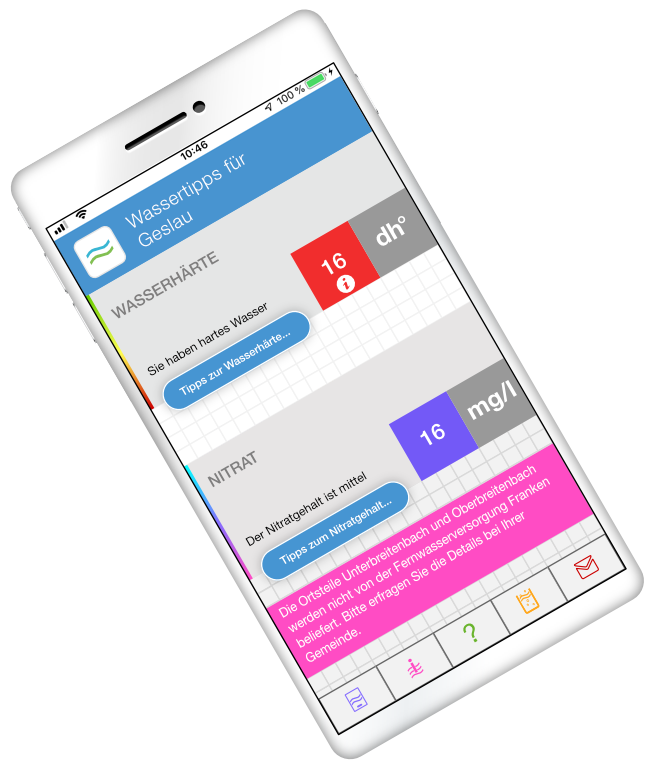We have collected water values for over 500 million people in many in many European countries and are constantly adding more countries to our collection. Our aim is to be able to provide an overview of drinking water quality for at least 80% of the population of the European countries.
In some cities, the water quality differs significantly depending on the district, even though the postcodes are the same. In order to achieve the greatest possible accuracy here, we have created our own GEO polygons in our water database, which map the actual water supply zones of the public water suppliers independently of the postcode boundaries.
Our map shows you which areas have already been recorded. There you can also view the values for each recorded area.
We have developed the Wassertipps app to provide you with these collected water values in a way that is suitable for everyday use and with added value.
The Water Tips Baby&Family app will follow in the course of the year.
Water hardness
Soft, 0 - 8,4 °dH (<1,5 mmol/l)
Medium, 8,4-14 °dH (1,5-2,5 mmol/l)
Hard, 14 °dH (> 2,5 mmol/l)
Nitrate level
0 - 10 mg/l
10,1 - 25 mg/l
25,1 - 50 mg/l
Our database
Our database currently includes most cities with more than 10,000 inhabitants and many smaller towns in Germany, Austria, Switzerland, Liechtenstein, Luxembourg, Belgium, the Netherlands, France, Great Britain, Ireland, Denmark, Sweden, Norway, Finland, Italy, Spain, Portugal, Poland, the Czech Republic, Slovakia, Slovenia, Hungary, Romania, Bulgaria, Serbia, Croatia, Turkey and Greece. This means that water values are currently available for around 500 million people in these countries.
The values determined are continuously supplemented, checked and updated if necessary. You can find out why our data is particularly accurate and everything else you need to know about the data and the percentage distribution of water hardness and nitrate content on the page Data.
Water hardness
Whether hard or soft water comes out of your tap depends on many factors, for example whether your water supplier obtains the water from so-called surface water such as rivers, lakes or reservoirs or whether it is pumped up from deeper groundwater layers.
While surface water is usually very soft, water from groundwater layers that has seeped through soils containing carbonate rock tends to be hard in the vast majority of cases.
Did you know: Soft water with a maximum hardness of 1.5 mmol/l, which is preferred by most people, is only available to around 1/3 of the population in Europe.
Enter a postcode or town here and find out whether the water there is soft, medium-hard or hard.
Water on everyone's lips... (our water blog in german)
In recent years, nitrate levels in groundwater have continued to rise despite warnings from water suppliers and environmental organisations
Current investigations by water suppliers have measured nitrate levels at over 26% of all measuring points that are several times higher than the permitted maximum value of 50 mg/l (Nitrate Report 2020 of the Federal Republic of Germany),sometimes even over 400mg/l.
Most experts agree that the increased nitrate content of groundwater is primarily caused by the way fertilisers are used in conventional agriculture.
Organic farms aim to achieve as closed a nutrient cycle as possible. In this way, they make a valuable contribution to soil and water protection.
You can find out what groundwater pollution means for our drinking water and therefore for each and every one of us on our Nitrate project page.
Based on our extensive data collection, we have already been able to carry out an initial evaluation of the distribution of nitrate concentrations in public drinking water in Germany and Austria.
You can find the results on our study page.




